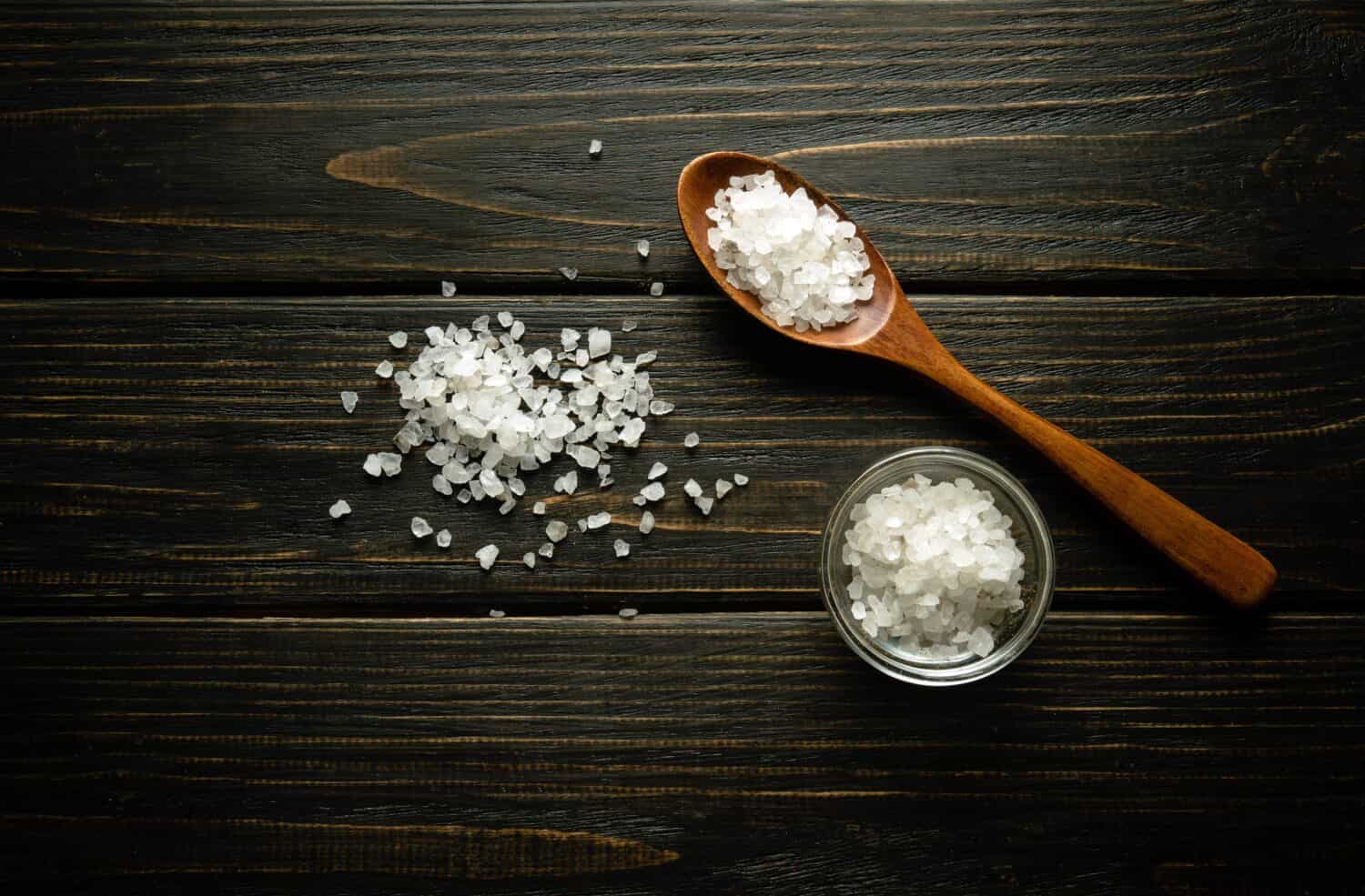You’ve definitely used salt before, but have you ever thought about what it truly is? What about MSG? These two flavor-packed compounds are quite common in our lives. But how much do you really know about MSG vs. salt? Firstly, what even are they? MSG, or monosodium glutamate, is a sodium salt-based flavor additive. It is common in canned and frozen foods, dietary supplements, salad dressings, and many more areas of the food and restaurant industry. Compare this with table salt. The sodium- and chloride-based compound goes a long way with just a pinch, and using too much makes food inedible!
These two have different chemical makeups and different origins, even if they both contain amounts of sodium. Many people debate the pros of using MSG over typical table salt because of its lower sodium levels. However, the FDA still requires MSG to be declared on any food label. This is for when it is not naturally present already in that food. Let’s get into some more of the comparative details between them.
In this post, we’ll discuss the major differences between MSG vs. salt. You’ll learn how they are processed and how long they’ve been around. Learn about some of their popular uses and their chemical makeup. Consider this article a deep dive into everything you’ve ever wanted to know about the unique qualities of MSG vs. salt. Happy reading!
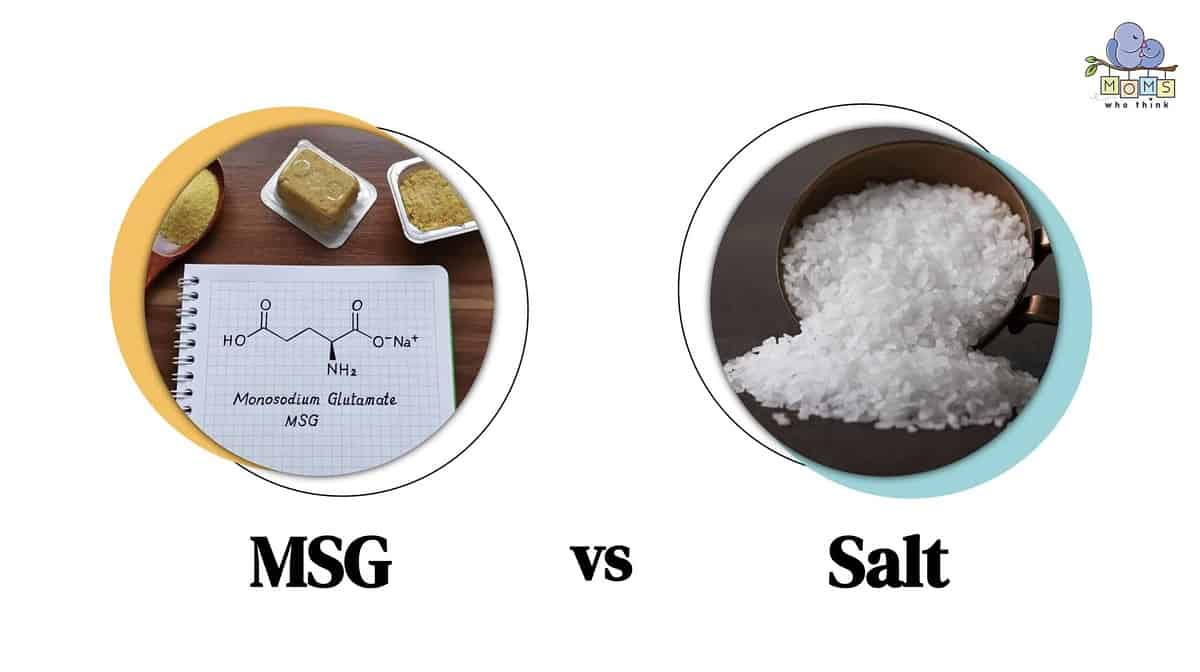
©
MSG vs. Salt: What Is The Difference?
MSG is a commonly used flavor additive that enhances the flavor and mimics salt with far less sodium content. Salt is a naturally occurring compound that comes from evaporated seawater or is mined from rock salt beds. While both have sodium components, when considering MSG vs. salt, remember that they come from different processes, and each has its unique flavorings.
What Is MSG?
MSG, or monosodium glutamate, is a sodium salt extracted from glutamate, an amino acid compound. While it is predominantly considered an additive, it naturally occurs in certain vegetables, egg yolks, dairy products, and seafood like anchovies and shrimp. It can also be achieved through the process of fermenting certain foods (via Medical News Today). These include sugar cane, sugar beet, seaweed, beans, and mushrooms. While there have long been controversial opinions on whether MSG is safe, the FDA has qualified the ingredient as generally safe. There were some reported side effects that cannot be directly linked to MSG sensitivity. Overall, experts actually theorize that replacing certain salty foods with MSG additives would dramatically reduce the high intake of sodium present in many people's diets. We'll talk more about this later on; keep on reading!
History and Origin Of MSG
It all starts with L-glutamate, the amino acid. Glutamate was discovered in 1908 by Kikunae Ikeda, a Japanese professor of physical chemistry. Professor Ikeda found a way to extract glutamate from seaweed, dissolve its crystalline form in water, and combine it with sodium hydroxide to produce MSG. First used primarily in broths and soups, MSG eventually became popular in many flavorful Asian dishes, canned products, and deli meats. Early distrust of MSG was linked to poorly performed experiments, including too small sample sizes, inadequate control groups, and other features of human error. There was also some anti-Asian sentiment that contributed to the rumor mill. Modern-day MSG facts heavily emphasize that there has been no link between the sodium-salt additive and the reported side effects, and it continues to be used to flavor foods all over the world (via Healthline).
How MSG Is Made
L-glutamate naturally occurs in seaweed, some vegetables, and certain fish, and the process for making MSG includes extraction and crystallization. These days, it is made from the fermentation of starch, sugar beets, and sugar cane in a method quite similar to the creation of wine and yogurt. A common misconception is that MSG contains gluten because it has the word “glutamate” in the title. This is not true; glutamate and glutamic acid have no connection to gluten found in wheat (via FDA).
Popular Uses
As mentioned above, MSG is used in numerous products of the food industry, both as an additive and, in some cases, naturally occurring. Some of these include meat production (as well as fish and seafood,) certain cheeses, vegetables, processed deli meats, salad dressings and condiments, frozen, canned, packaged foods, certain seasonings, and meat rubs. Since it does have less sodium than table salt, it can be a great way to increase flavor while decreasing sodium intake!
What is Salt?
Salt, or sodium chloride (NaCl), is a byproduct of seawater evaporating and leaving crystals behind. It is used in recipes for flavor, chemical processes for stabilizing, and food preservation for its anti-bacterial properties (via Brittanica).
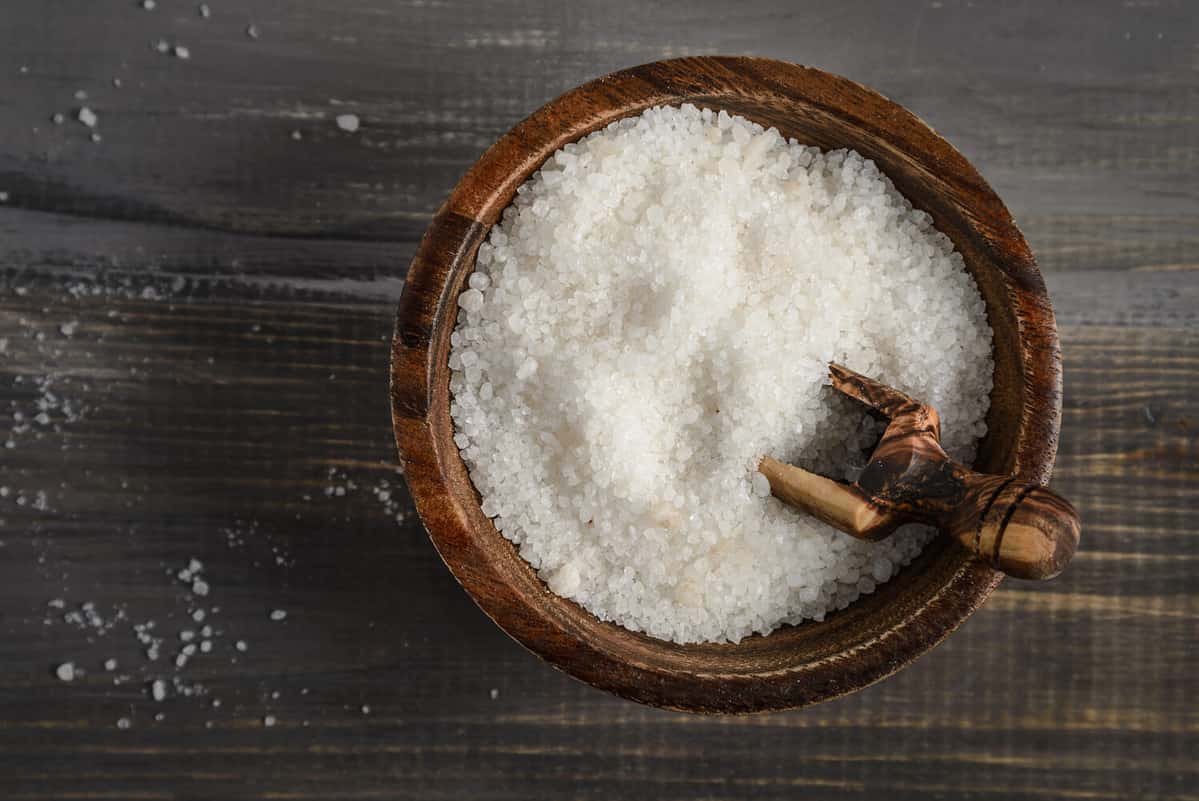
Salt has been around for thousands of years and is used in all kinds of ways around the world.
©Albina Bugarcheva/Shutterstock.com
History and Origin Of Salt
Salt has been a commodity for as long as humans have been alive, and far before that, it existed naturally without being harvested at all. Animals consumed naturally occurring salt, and as the first humans' diets shifted from only meat to other plants and grains, they had to find ways of adding salt back into their diet. Salt mines weren't an option before the right tools were invented, so for a long time, the demand for salt was high, but the supply could only come from dried-up seawater, which left little behind. It became a trading resource, and the salt trade spread across the Mediterranean.
Salt trading traces back to the 6th century in parts of the Sahara desert. And salt cakes were traded across areas of Central Africa. Salt was also used as an antiseptic in parts of ancient Rome. According to Time Magazine, even the phrase ” he was not worth his salt,” can be traced to the trade of salt when it was used for buying slaves. In short, this mineral compound has always held value, and though it is mass-produced and widely available today, it is nonetheless a staple of our diets and our industrial presence in this world.
How Salt is Processed
Salt can be processed in quite a few ways. Naturally occurring beds of rock salt are mined, dissolved, and purified. The grain of the salt differentiates the way in which it is marketed. For instance, table salt is much finer than flake salt or pink salt crystals. Seawater is run through conditions that allow the brine to be extracted, crystallized using pans, and further purified with chemicals. Vacuum evaporators and grainer machines help to speed up salt creation. Certain grades of salt have specific ways of being processed for packaging and eventual sale (via Brittanica).
Popular Iterations
There are six major types of salt, as outlined by the Farmer's Almanac. These include:
- Table salt, highly processed and fine, is used most for cooking and mealtimes
- Kosher salt features coarser, larger crystals
- Himalayan Pink salt is mineral-rich, which is why it has a distinctive pink coloration
- Sea salt, a classic salt ideal, comes directly from seawater!
- Pickling/Canning salt contains no additives and is highly concentrated to ensure the preservation
- Black salt is processed with high heat and added spices, giving it a unique flavor for cooking
Nutritional Value
A high intake of sodium can result in hypertension or high blood pressure. The recommended intake is no more than 2,300 mg per day, about a teaspoon (via American Chemistry Society). Check out this handy chart below to get a better idea of the nutritional comparison of MSG vs. salt.
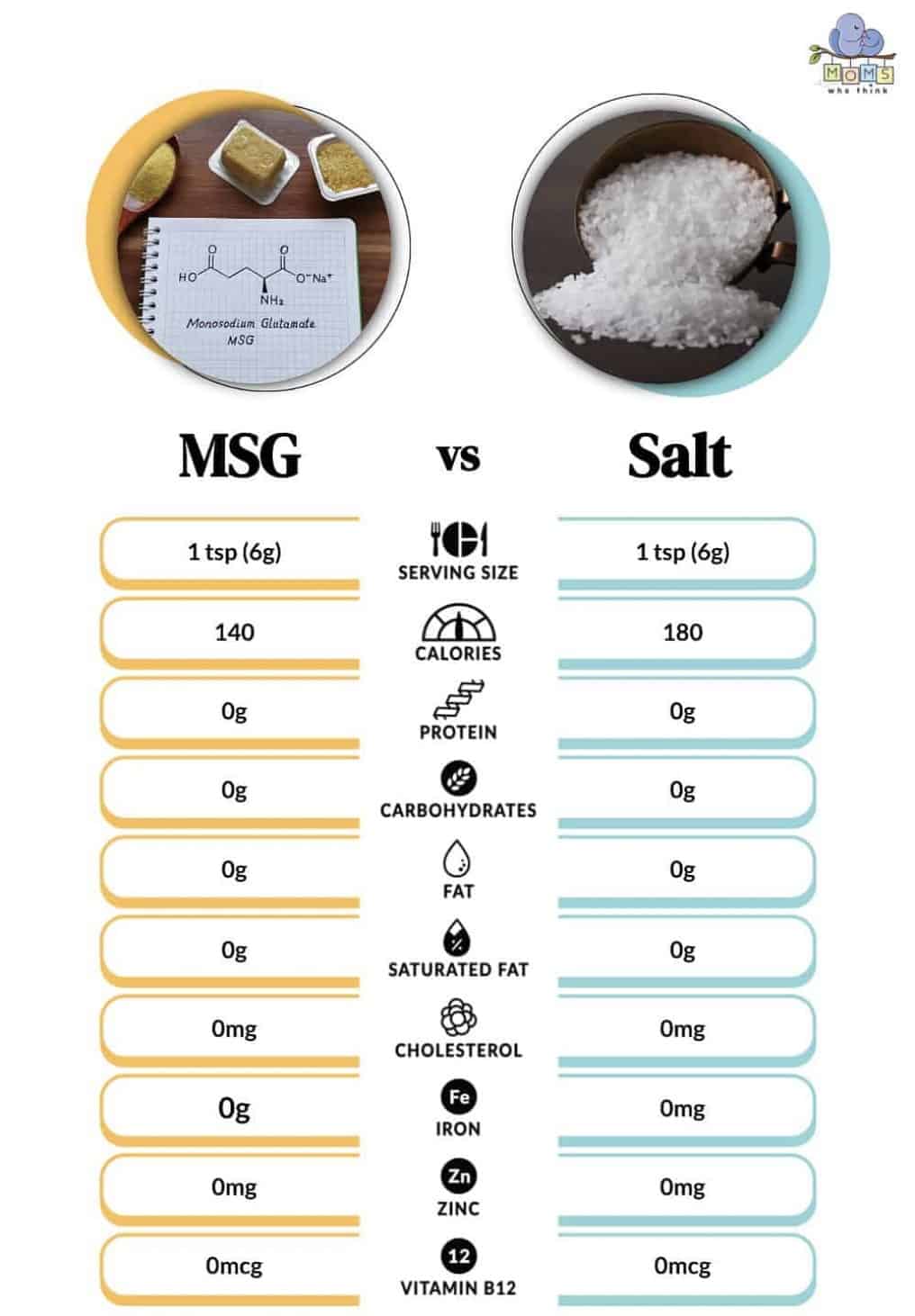
Possible Alternatives To MSG and/or Salt
In terms of swapping out salt in your cooking, MSG is the easiest alternative. However, you can pack a flavorful punch into your cooking without using either additive at all. Healthline recommends trying out some of the following. Use garlic, black pepper, lemon zest, onion, vinegar, truffle oil, ginger, paprika, tarragon, or coconut aminos in your flavorings. Use your imagination and find some nuanced flavor combinations that don't have salt!
Comparison of MSG vs. Salt
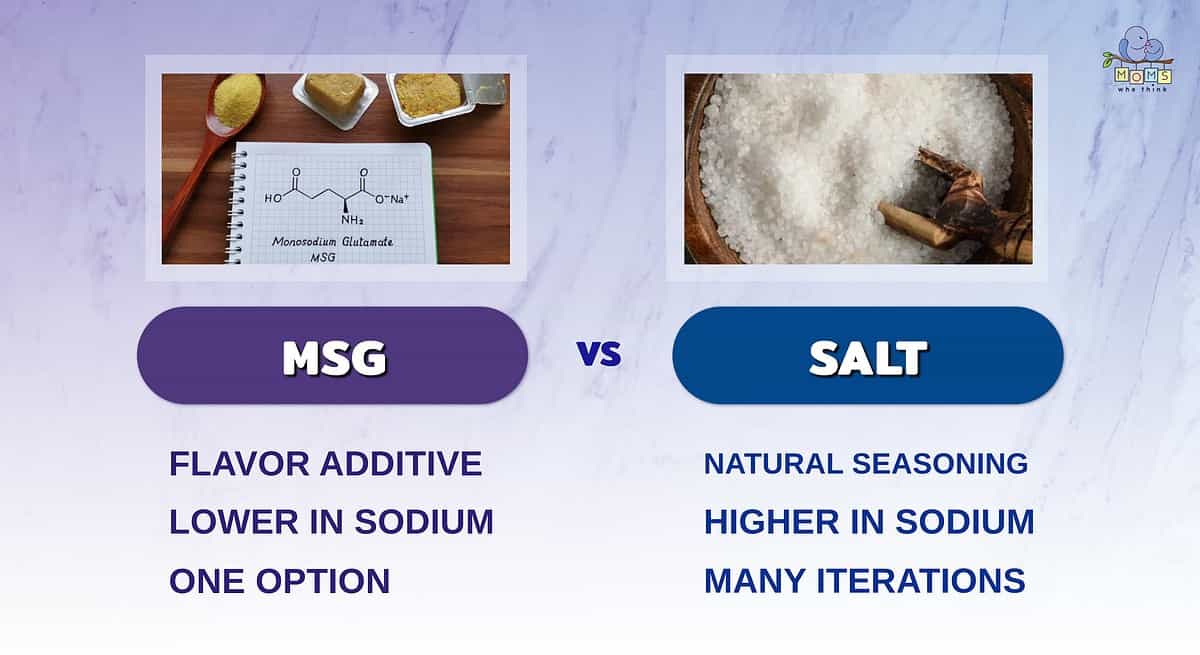
While they serve different purposes and can be somewhat interchangeable, MSG and salt are both flavorings that add something more to meals. But to recap, here are a few of the differences between the two:
- Salt is considered a naturally occurring compound. On the other hand, MSG is a sodium salt that is generally considered an additive.
- Both are generally considered seasonings. However, MSG has lower sodium than regular salt.
- There are many different options and iterations of salt. MSG usually has just one option.
Many recipes out there use salt as one of their ingredients. If you're on the hunt for a new recipe to try, check out this delicious chicken saltimbocca with a mushroom sauce:
PrintChicken Saltimbocca with Mushroom Sauce
- Yield: 8 servings
Ingredients
½ cup all-purpose flour
¼ teaspoon salt
½ teaspoon pepper, divided
8 boneless skinless chicken thighs (2 pounds)
2 Tablespoons olive oil, divided
2 cups sliced fresh mushrooms
2 thin slices prosciutto or deli ham
½ cup chopped shallots
2 garlic cloves, minced
1 cup white wine or reduced sodium chicken broth
1 cup reduced sodium chicken broth
⅓ cup half and half cream
3 Tablespoons fresh sage or 3 teaspoons dried sage leaves, divided
1 can (15 ounces) white kidney or cannellini beans, rinsed and drained, divided
¼ cup water
Instructions
1. In a large resealable plastic bag, combine the flour, salt, and ¼ teaspoon pepper. Add chicken, a few pieces at a time, and shake to coat.
2. In a large skillet over medium heat, cook chicken in 1 Tablespoon oil for 6 to 8 minutes on each side or until juices run clear. Remove and keep warm.
3. In the same skillet, sauté the mushrooms, prosciutto, shallots, and garlic in remaining oil until tender.
4. Stir in wine. Bring to a boil; cook until liquid is reduced to about ⅓ cup, about 10 minutes.
5. Stir in broth. Simmer, uncovered, for 5 minutes or until slightly reduced.
6. Stir in cream and 2 Tablespoons sage; heat through (do not boil).
7. Meanwhile, in a small saucepan, lightly mash ½ cup beans; add the water. Stir in the remaining pepper, sage and beans. Heat through.
8. Add chicken to the mushroom mixture and heat through. Serve with beans.
Nutrition
- Serving Size: 1 serving
- Calories: 290
- Sodium: 371mg
- Fat: 13g
- Saturated Fat: 4g
- Carbohydrates: 14g
- Fiber: 3g
- Protein: 26g
- Cholesterol: 84mg
The image featured at the top of this post is ©VITALII BORKOVSKYI/Shutterstock.com
